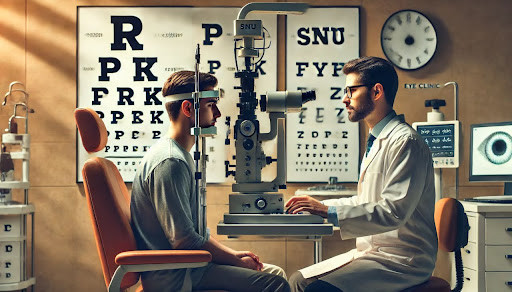Laser eye surgery has changed the lives of millions of people worldwide by providing freedom from glasses and contact lenses. Two of the most widely performed procedures—LASIK (Laser-Assisted In what is lasik Situ Keratomileusis) and PRK (Photorefractive Keratectomy)—offer safe and effective vision correction for many common refractive errors. However, not everyone is an ideal candidate for these surgeries.
Understanding the qualifications and limitations of LASIK and PRK is essential for making an informed decision. In this article, we explore the factors that determine candidacy, the differences between the procedures, and who might benefit most from each.

Understanding LASIK and PRK
Both LASIK and PRK use an excimer laser to reshape the cornea, allowing light to focus correctly on the retina. This corrects refractive errors such as:
- Myopia (nearsightedness)
- Hyperopia (farsightedness)
- Astigmatism
- Presbyopia (age-related reading difficulty) — to a limited extent
The Main Difference:
- LASIK involves creating a thin flap in the cornea, lifting it, reshaping the tissue underneath, and repositioning the flap.
- PRK removes the surface layer of the cornea (epithelium), reshapes the tissue underneath, and lets the epithelium regenerate naturally.
Though both procedures offer similar long-term visual outcomes, certain anatomical and lifestyle factors can influence which surgery is safer or more effective for a given individual.
General Candidacy Requirements for LASIK and PRK
Before diving into the unique suitability for each procedure, here are universal criteria that apply to both:
✅ Age 18 or Older
Vision should be fully developed. Eye prescriptions must be stable for at least 12 months.
✅ Stable Prescription
Candidates should have no significant changes in their glasses or contact lens prescription for at least one year.
✅ Healthy Eyes
Eyes should be free from active infections, inflammation, severe dry eye syndrome, or diseases like keratoconus or cataracts (unless cataract surgery is being planned instead).
✅ Realistic Expectations
Understanding that laser surgery improves vision but may not always result in perfect 20/20 vision, especially in complex cases or with age-related conditions like presbyopia.
✅ Overall Health
Good general health with no autoimmune diseases (e.g., lupus, rheumatoid arthritis) or conditions that affect healing, such as uncontrolled diabetes.
Who Is a Good Candidate for LASIK?
LASIK is the preferred choice for many people due to its fast recovery, minimal discomfort, and rapid visual improvement. Ideal candidates for LASIK generally meet the following conditions:
➤ Sufficient Corneal Thickness
Creating a flap in the cornea requires enough corneal tissue. Thin corneas may not support LASIK safely.
➤ No History of Eye Trauma
Those who participate in high-risk contact sports or have had eye injuries may be at greater risk of flap complications, making LASIK less advisable.
➤ Mild to Moderate Refractive Errors
LASIK is highly effective for treating a broad range of nearsightedness, farsightedness, and astigmatism—especially when the prescription isn’t extremely high.
➤ Normal Pupils in Low Light
Very large pupils may increase the risk of post-operative night vision issues such as glare and halos.
➤ Low Dry Eye Risk
Since LASIK may worsen dry eyes, it’s better suited for people with normal tear production or manageable dry eye symptoms.
Who Is a Good Candidate for PRK?
PRK is an excellent alternative for people who aren’t eligible for LASIK due to anatomical or lifestyle reasons. While the recovery is slower and initial discomfort is greater, PRK is equally effective in the long term. Good candidates include:
➤ People with Thin or Irregular Corneas
PRK does not involve creating a corneal flap, so less tissue is removed. This makes it safer for those with corneas that are too thin for LASIK.
➤ Athletes or Military Personnel
Since PRK doesn’t involve a flap, there’s no risk of flap dislocation from trauma. This is a major advantage for those in physically demanding or high-risk professions.
➤ Patients with Higher Risk of Dry Eye
PRK is less likely to worsen dry eye symptoms, making it more suitable for individuals who already suffer from dryness.
➤ Patients with Surface Irregularities
PRK can be beneficial for treating or smoothing certain surface irregularities that may not be addressed well with LASIK.
Who May Not Be a Candidate for Either Procedure?
There are situations in which neither LASIK nor PRK is advisable. These include:
- Unstable prescription
- Pregnancy or breastfeeding (hormonal changes can affect vision and healing)
- Autoimmune diseases or delayed healing conditions
- Severe dry eye that cannot be managed
- Advanced glaucoma or cataracts (requiring different surgical approaches)
- Active eye infections or recent eye surgeries
In such cases, your eye surgeon may recommend other solutions like implantable contact lenses (ICLs), refractive lens exchange (RLE), or simply continuing with glasses or contact lenses.
What to Expect in a Candidacy Evaluation
To determine if you’re a suitable candidate, your ophthalmologist or refractive surgeon will perform a thorough eye exam, which may include:
- Corneal thickness measurement (pachymetry)
- Corneal mapping (topography)
- Pupil size evaluation
- Dry eye assessment
- Prescription stability review
- General eye and medical history
They will also discuss your lifestyle, expectations, and any concerns you have about the procedure or recovery.
Final Thoughts
Both LASIK and PRK are life-changing procedures that offer safe, effective solutions to common vision problems. But they are not one-size-fits-all treatments. The best candidates are those who meet the medical criteria, have realistic expectations, and work closely with an experienced eye care provider to select the most suitable option.
If you’re tired of relying on glasses or contact lenses and want to explore your vision correction options, schedule a consultation with a qualified ophthalmologist. With the right procedure and proper guidance, you can move one step closer to clearer, more independent vision.
